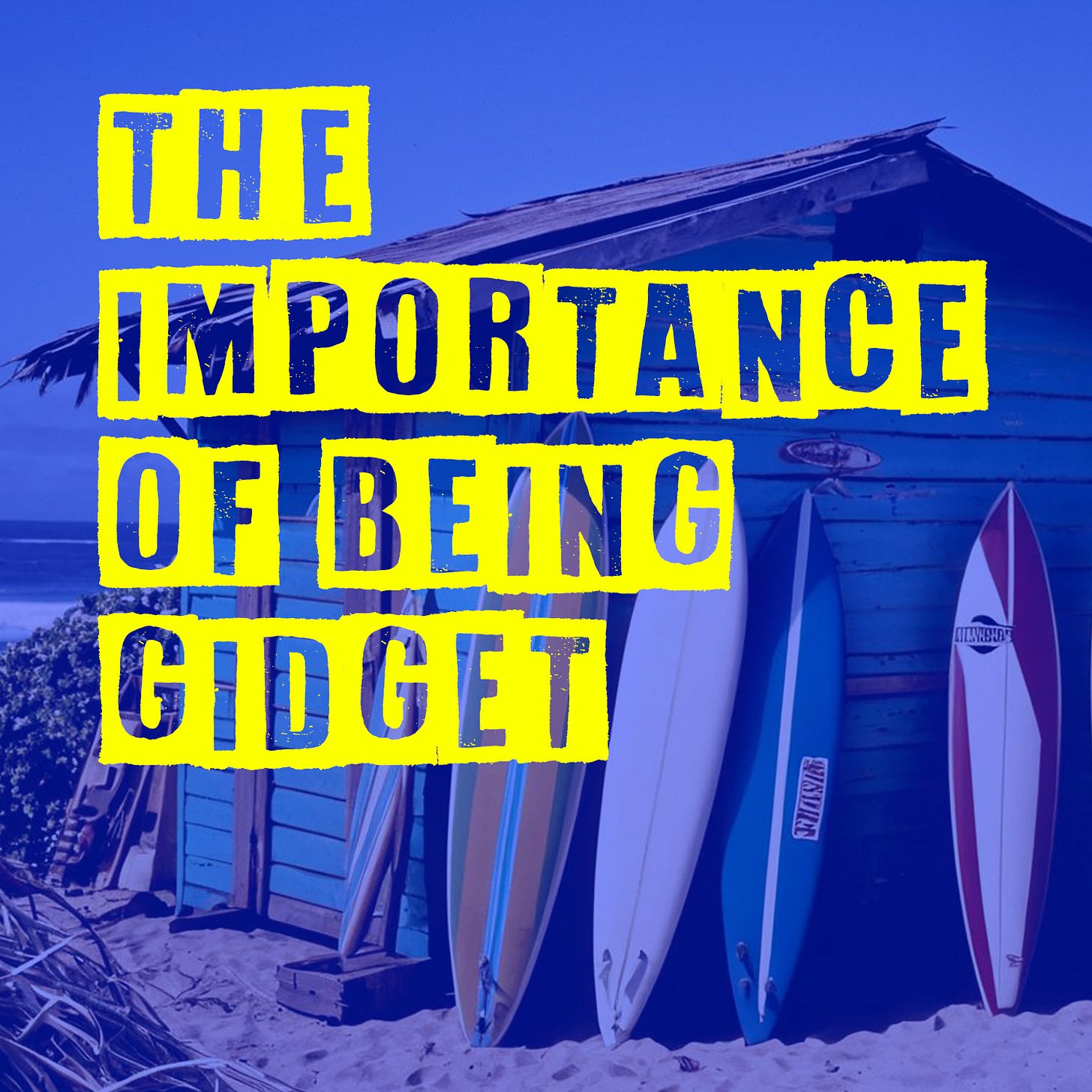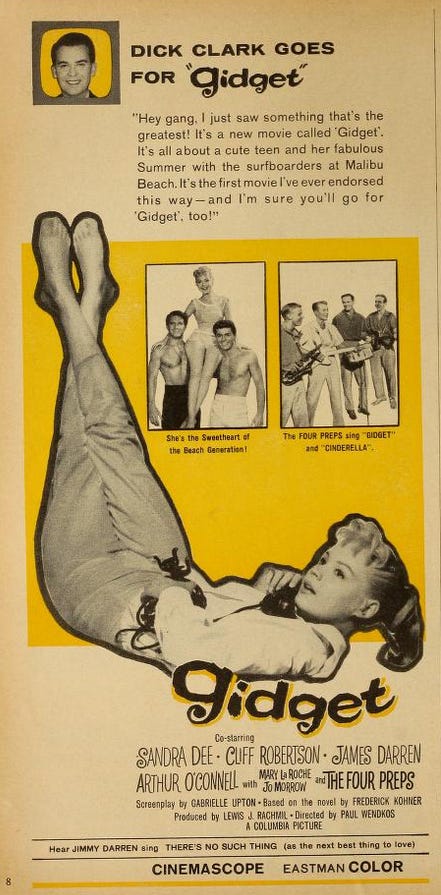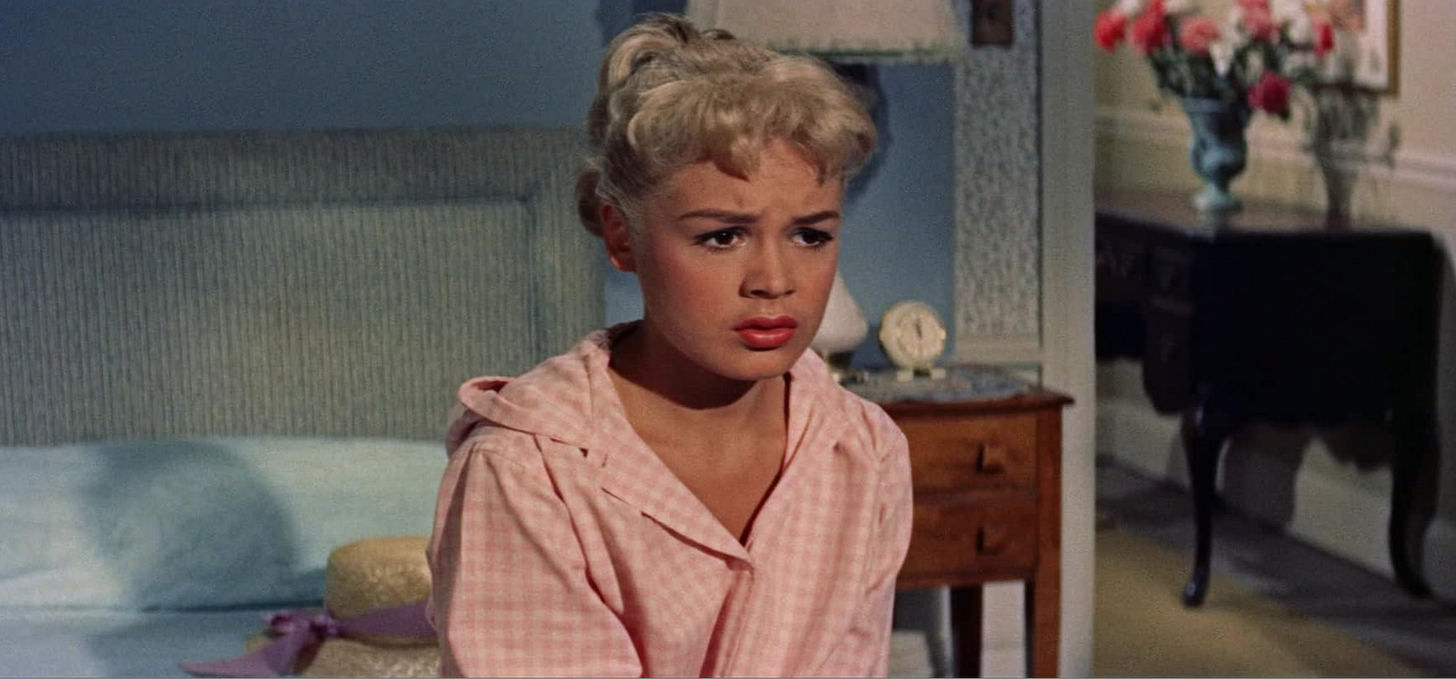The Importance of Being Gidget (Part 2): Gidget on the Big Screen
The 1959 hit film launched the Southern California surf craze . . . and the short-lived career of its young star, Sandra Dee, whose tragic life was not as idyllic as her onscreen counterpart
PLEASE NOTE: This article also includes an audio version of the author reading the article (above).
NOTE: In part 1 of this series, I explored the writing of the 1957 novel Gidget: The Little Girl With Big Ideas by Austrian-born novelist and screenwriter Frederick Kohner. In this article, I will switch my focus to the screen adaptation of Gidget, released in the United States in March of 1959, and its impact on the wider popular culture of the time. I will also shed light the life and career of teenage actress Sandra Dee, who played the main character, Francine, in the first film, which became the big sleeper hit of the year and was especially popular among young teenage women for its portrayal of a feisty, independent girl who teaches herself to surf. I hope you enjoy it. – AH
“Her wide appeal to her own generation as well as to adults stems from the fact that she seems to epitomize that nice ‘girl next door’…. The image she projects on screen is that of today's teenager beset by problems her own generation can sympathize with and understand…. Nearly always these problems involve parental relationships and dating, and Miss Dee solves them by relying on decent instincts and common sense.”
— Motion Picture Herald on Sandra Dee, 1959
“This summer was the turning point in my life. For 16 years, I'd gone blindly along enjoying myself like a fool who never guesses what's in store for her. Then . . .”
— Francine "Gidget" Lawrence, in the opening lines to Gidget (1959)
Picture this: Francine, an adventurous girl in her mid-teens, discovers the joys of surfing. She buys a surf board, learns how to use it, and she befriends a colourful group of young fellas who surf on the breathtaking beaches of the Pacific Ocean. The teenage female protagonist defies the odds – and the gender roles of the day – by learning to surf, widely thought to be a “man’s sport” in the late 1950s, when the story is set. She falls for one of the young surfers she meets, a cool-as-a-cucumber lad nicknamed Moondoggie. And she is intrigued by an older, slightly mysterious surfer in his 30s that everybody calls “Kahoona” . . .
Welcome to the movie Gidget, released in indoor and drive-in theatres across North America March of 1959. The film was shot in the summer of 1958, much of it on the shores of Leo Carrillo State Park in Malibu. Gidget – more than any other film from the era – helped to popularize what would become the nationwide surf craze of the 1960s, not to mention a rash of less compelling “Beach Party” imitators.
Dick Clark, host of the popular music variety TV show American Bandstand in the late 1950s, introduces the movie Gidget, which he enthusiastically endorsed and promoted on his various television and radio shows.
But what makes Gidget stand out as unique is that it was the first film to take a newly emerging sport at the time, surfing, associated mainly with men, and weaves it into a young woman’s coming-of-age story.
In doing so, it became one of several films released in 1959 that turned its star, Sandra Dee, into a household name. It was a busy year for the teenage actress. She appeared in such runaway box office successes as The Wild and the Innocent, A Summer Place and Imitation of Life. For complicated reasons, her star would only shine briefly. But Dee gave Gidget’s main character, Francine, a uniquely human face and helped turn the film into box office gold in the spring and summer of 1959.
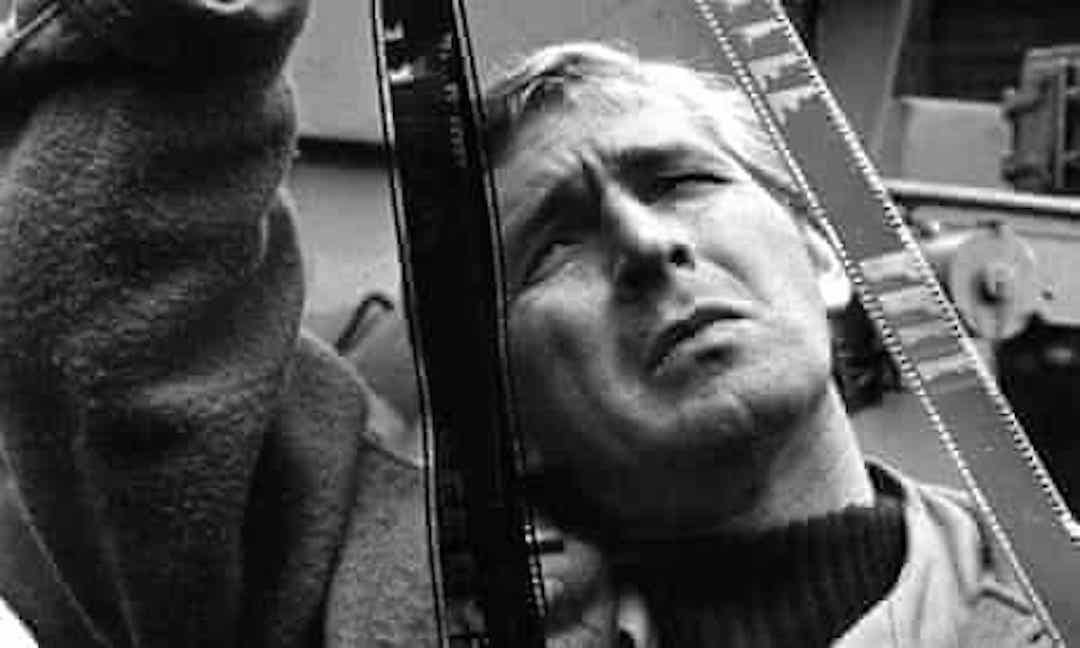
Gidget was an adaptation of the bestselling 1957 novel Gidget: The Little Girl with Big Ideas, written by Austrian-born American writer Frederick Kohner, based on the real-life surfing adventures of his daughter Kathy. Hollywood snapped up the rights to the novel. Paul Wendkos (1925 – 2009), director of such films as Tarawa Beachhead (1958) and Guns of the Magnificent Seven (1969), but known mainly for his work in television, directed the film.
While Gidget on the surface may seem like a lighthearted teen movie, it contains subtle proto-feminist themes. Francine’s determination to break into the male-dominated world of surfing can be seen as an early example of female empowerment on screen. Gidget is one of the few coming-of-age films made in Midcentury America that focused on a female perspective (A Tree Grows in Brooklyn, The Member of the Wedding, and To Kill a Mockingbird are a few other Midcentury films that show adolescent women coming of age).
The movie’s first half follows Francine’s efforts to learn how to surf and fit in with a group of teenage male surfers (whom she calls “Go-Heads”) with nicknames like Waikiki, Stinky, Lord Byron, Hot Shot, and Lover Boy. She falls for one of the surfers, Moondoggie (James Darren), a high school hot shot who’s emerging as one of the lead surfers of the group.
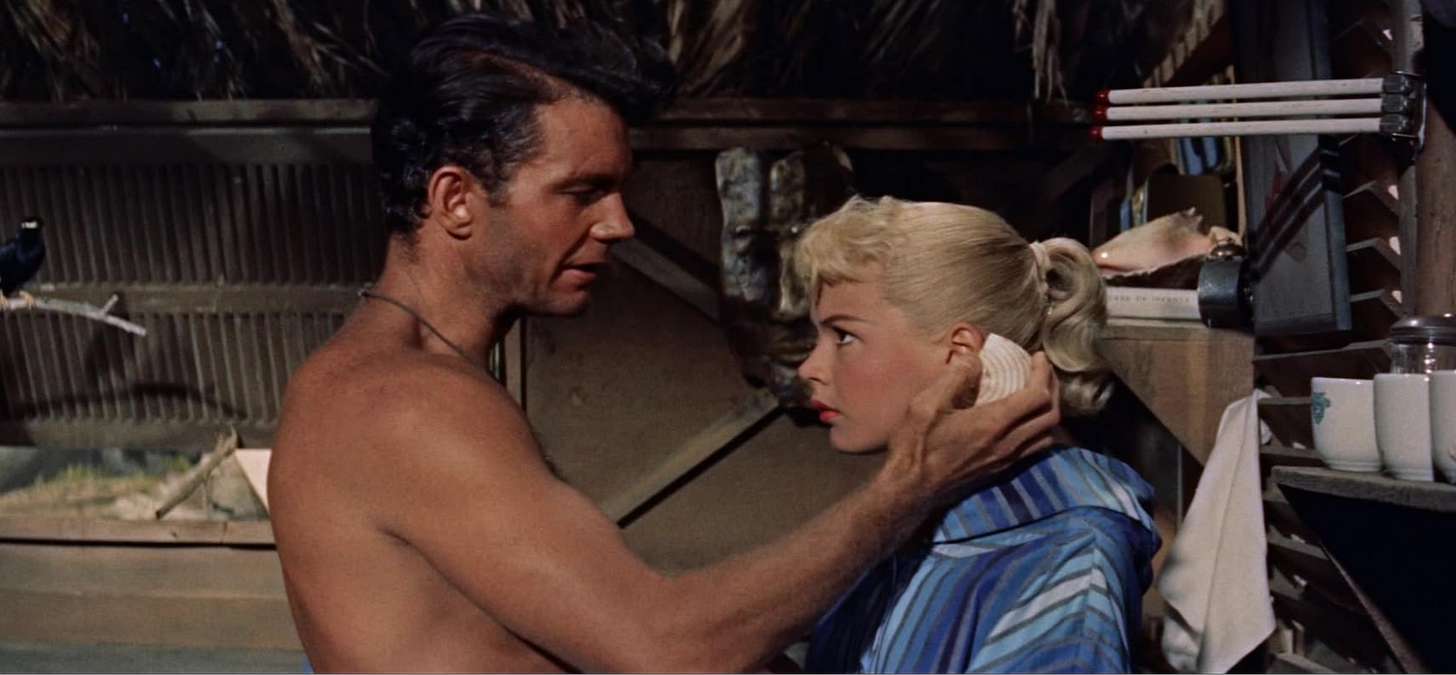
The lads all look up to a devil-may-care, 30something surfer named Burt "Kahoona" Vail, whose nickname is derived from the Hawaiian word “Kahuna,” meaning person in charge, expert, shaman, priest, and sometimes “healer.” The word was also used by surfers to describe a big wave. Kahoona is played by Cliff Roberson, a fine actor and rising star in the 1950s who was 36 when he co-starred in Gidget.
Kahoona – role model to the younger surfers around him – is a true nonconformist: He follows the waves, wherever they may take him. He has surfed in such faraway spots as Hawaii and Peru. He lives in a wooden shack mere yards from the ocean. He shares his digs with a squawking bird. He surfs all day and smokes cigarillos that look vaguely like joints. He wears a straw hat and he’s such skilled surfer that it stays on his head while he rides the waves. He’s masculine, and he lives a mellow beach bum life, with no known source of income.
But the movie Gidget is really about Francine (Sandra Dee). She is so petite that her diminutive stature earns her the portmanteau nickname “Gidget,” which her fellow surfers have derived from a combination of the words “girl” and “midget.”
Much of Gidget focuses on Francine mastering surfing. She purchases a surf board, handmade by a local beach bum, and she proves to the other boys that she can surf as well as they can. “This surfboard is a gilt-edge guarantee for a summer of sheer happiness,” she joyfully proclaims. Elsewhere in the film, she chimes: “Surfing is out of this world. You can't imagine the thrill of the shooting the curl. It positively surpasses every living emotion I've ever had.”
When Kahoona asks Francine if she’s done much surfing, she responds: “Uh, no, not too much. Yesterday was my first. Boy, was it ever exciting! It was like nothing I ever felt before! Whoop! We're on an elevator headed for the sky. And then, zoom! Speeding across the ocean, on top of the world! It was the ultimate!”
Francine is a natural on the surf board. And while she eventually gets entangled in romance, she makes her ambivalence about boys known to her mother: “I mean, well, boys are the most fun, but – well, I mean, I just can't stand when they start smooching and pawing and . . . Well, level with me, Mom, doesn't that kind of stuff make your skin crawl?”
The second half of Gidget shifts focus to the budding romance between Moondoggie and Francine. The young man breaks out into song a couple of times in the film, impressing Francine with his vocal abilities. But Moondoggie plays it cool with Francine, ignoring her gentle overtures to him. Unsure of each other, the two engage in cat-and-mouse antics. They even involve Kahoona in their adolescent high jinks, which leads to a temporary falling out between Kahoona and jealous Moondoggie, who thinks the older surfer is hitting on Francine.

Despite its romantic elements aimed at teenagers, Gidget was ahead of its time, especially in its focus on a child-like female protagonist. Many young female viewers could relate to Francine in 1959. She works hard in the movie to prove herself as a worthy surfer. At first, she is regarded a mascot by the male surfers, but she earns their respect.
The film never sexualizes Francine, either, which many films, television shows, and songs during this era tended to do with teenage women. Gidget instead treats Francine as a wide-eyed, naïve girl who’s less interested in hunting for boys than her female friends. She prefers to surf like the fellas on the beach with crazy nicknames.
The film’s refusal to turn Francine into a teenage sexpot is made evident by her loose-fitting bathing suits, created by Canadian-born swimsuit maker Rose Marie Reid, a devout Mormon and one of the most celebrated swimsuit designers in Hollywood. Reid tended to prefer modest designs, and the swimsuits she created for Dee look baggy on the actress and make her appear even younger than 16.
Ultimately, Gidget is a product of its times. It contains campy parts, including kitschy backscreen effects during surfing scenes, corny harmonizing by the group the Four Preps, who break out into song at a big Hawaiian-style “luau,” and a lot of unanswered questions about why Francine – who’s from an upper-middle class family – can so easily sneak away to the beach on a daily basis and stay there all day long surfing.
The screenplay to Gidget, written by Canadian-born female screenwriter Gabrielle Upton (who also wrote under the pseudonym Gillian Houghton), never loses sight of its female protagonist. Francine’s evolution – even with all the film’s campy moments – is believable and poignant.
Gidget made boatloads of money for Columbia Pictures. Along with the novel upon which it was based, Gidget launched the musical “Beach Movie” craze of the 1960s – films such as Beach Party (1963), Muscle Beach Party (1964), Beach Blanket Bingo (1965), and How to Stuff a Wild Bikini (1965), to name a handful, which depicted carefree “teenagers” (most of them depicted by actors and actresses well into their twenties) singing, surfing, and frolicking on California’s warm, sunny beaches.
The breathtaking opening credit sequence for Gidget (1959) — containing the film’s ebullient theme song — is a work of great Midcentury art unto itself.
Gidget generated a pair of successful sequels, Gidget Goes Hawaiian (1961), starring Deborah Walley as Francine, and Gidget Goes to Rome (1963), with Cindy Carol in the title role, as well as a television show starring Sally Field. It also became an effective launching pad for Southern California surfing culture, and the film inspired that vibrant scene’s magnificent soundtrack provided by the likes of Dick Dale & His Del-Tones, Jan and Dean, The Beach Boys, and countless instrumental surf groups.
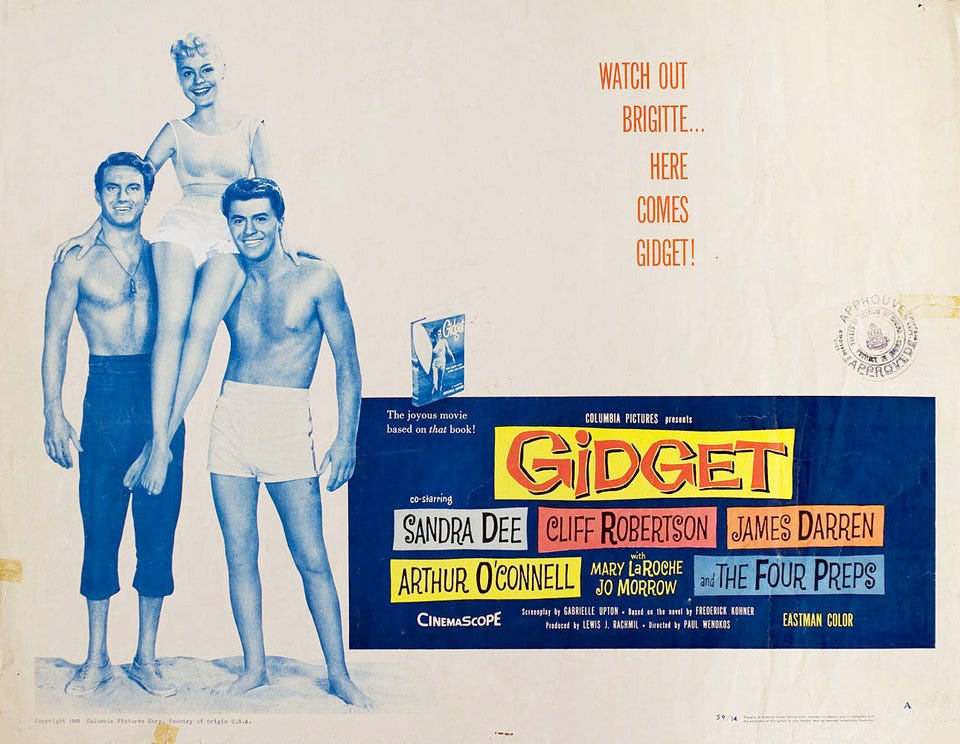
Sandra Dee, who only starred in the first film, emerged as the biggest female teen celebrity in the United States in the late 1950s and early 1960s, thanks largely to the huge success of Gidget. She starred in other youth-oriented films, and she crisscrossed the country on a studio-financed publicity tour that drew crowds of enthusiastic teenagers wherever she went.
Dee also appeared on the covers of glossy fan magazines and teen-oriented periodicals, which portrayed her as a real-life version of Francine in Gidget. Her media-crafted persona as being bubbly, sweet and innocent, set the bar high for millions of female teenagers. The press promoted her as younger version of Doris Day.

“She was what I hoped to be like – a darling girl, a perfect figure, pretty smile and dimples, all the clothes in the world and many boyfriends, plus an outstanding personality... I saw all the films she made and read all the articles in movie magazines on her,” wrote an adolescent female to a fan magazine.[1]
On December 1, 1960, 18-year-old Sandra Dee married popular crooner, actor and heartthrob Bobby Darin, an event that generated an avalanche of publicity and reinforced her celebrity status. The two met during the filming of Come September, a movie in which they co-starred. Newspapers portrayed their whirlwind 10-minute wedding ceremony at a friend’s home in Elizabeth, New Jersey, as the pinnacle of a storybook romance.[2]
But Dee’s youth was not as idyllic and carefree as the publicity surrounding her would have people believe. Unbeknownst to the public, her early life was marred by trauma and abuse. Her father, John Zuck, abandoned Sandra and her mother, Mary, when Sandra was a little girl living in Bayonne, New Jersey. After divorcing her first husband, Mary married a real estate executive, Gene Douvan. Dee later claimed that Douvan sexually abused her for years.
That agonizing ordeal cast a long shadow over Dee’s life and career, contributing to the personal challenges she faced. She had a difficult relationship with her mother right up until Mary died in 1987. Dee also struggled for years with eating disorders and substance abuse, especially heavy drinking.
But Dee was more than a victim of sexual abuse. She was a talented actress and a complex woman who navigated her way to fame through extraordinary circumstances. In the early 1960s, her career continued to follow a promising trajectory with a steady stream of starring roles in romance films, dramas, and light comedies.
As the years passed, however, Dee’s career declined. The roles began to dry up. After 1967, Dee – who began the decade topping the list of box-office stars – could no longer find good parts in films. Her last major starring role in a theatrical feature film was in the low-budget shocker The Dunwich Horror (1970), after which she only appeared in a handful of made-for-TV movies and as a guest star on television shows.
Dee’s marriage to Bobby Darin ended in divorce in 1967, the same year she was dropped by her studio, Universal. She and Darin remained close after their divorce, but the singer/actor suffered from a number of health problems, and he died in 1973 at age 37. Darin’s death hit Sandra Dee hard. Her alcoholism grew worse. She appeared as a guest star on various TV shows over the years – Night Gallery, Police Woman, Fantasy Island – but her career as a movie actress was effectively over.
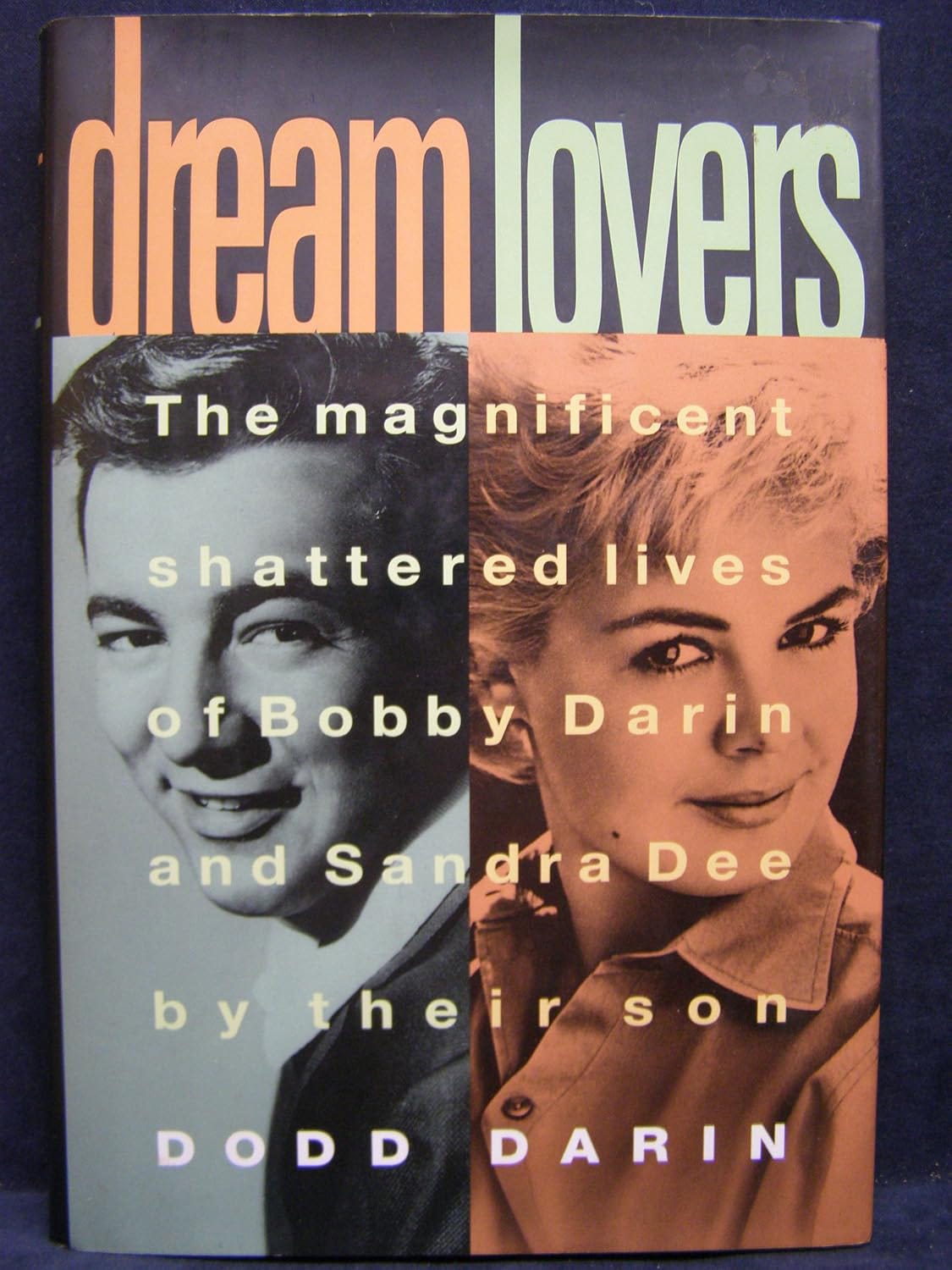
In 1994, Dodd Darin, son of Bobby Darin and Sandra Dee, wrote a memoir about his famous parents titled Dream Lovers: The Magnificent Shattered Lives of Bobby Darin and Sandra Dee. The extraordinary book is written in a candid and engaging fashion, and it feels like listening to an old friend talking about his family’s fascinating life.
By this time, Dee was trying to come to terms with the years of sexual abuse that she suffered from at the hands of her stepfather, Gene Douvan, who had died decades earlier. She was struggling with anorexia and alcoholism, and she relied heavily on her son Dodd – an only child – for emotional support. In his memoir of his parents, Dodd wrote that his mother expressed regrets about the decline of her acting career. “She says how sorry she is that her career ended,” Dodd wrote. “That she misses it. That acting is the only work she knows.”[3]
Dee was constantly hard on herself. She once said she was “a has-been who never was.”[4]
In the early 1990s, Sandra Dee – who was in therapy regularly by this time – decided to go public about her stepfather sexually abusing her. She was on the cover of the March 18, 1991, issue of People magazine, and she appeared on the Sally Jessy Raphael Show, a popular nationally syndicated television interview talk show.
Sandra Dee bravely opens up about the sexual abuse she endured as a little girl on a 1991 episode of the Sally Jessy Raphael Show. She talks about some very painful experiences here. If you’re a sensitive soul, you might not wish to watch it.
More than a quarter of a century before the #MeToo movement emerged, Dee bravely shared the details of the molestation she experienced as a child. The abuse began when she was five, and it continued for years. Unlike Francine in Gidget, Dee had her innocence violently ripped away from her by a man who was supposed to be a parental figure in her life. A man who was physically much larger and more powerful than her. A predator who could easily have his way with her.
She kept that agonizing secret hidden for decades, ashamed to tell the world of the suffering she had endured in her youth.
When Dee finally made these details known to the public, she did so because she did not want other innocent people who had been through similar experiences to suffer in silence. Many victims of sexual abuse found it too painful to reveal what had happened to them. However, when Sandra Dee, who’d once been a famous movie star, opened up about her personal trauma, millions of people read about it in People and watched her on the Sally Jessy Raphael Show. And they no longer felt so alone.
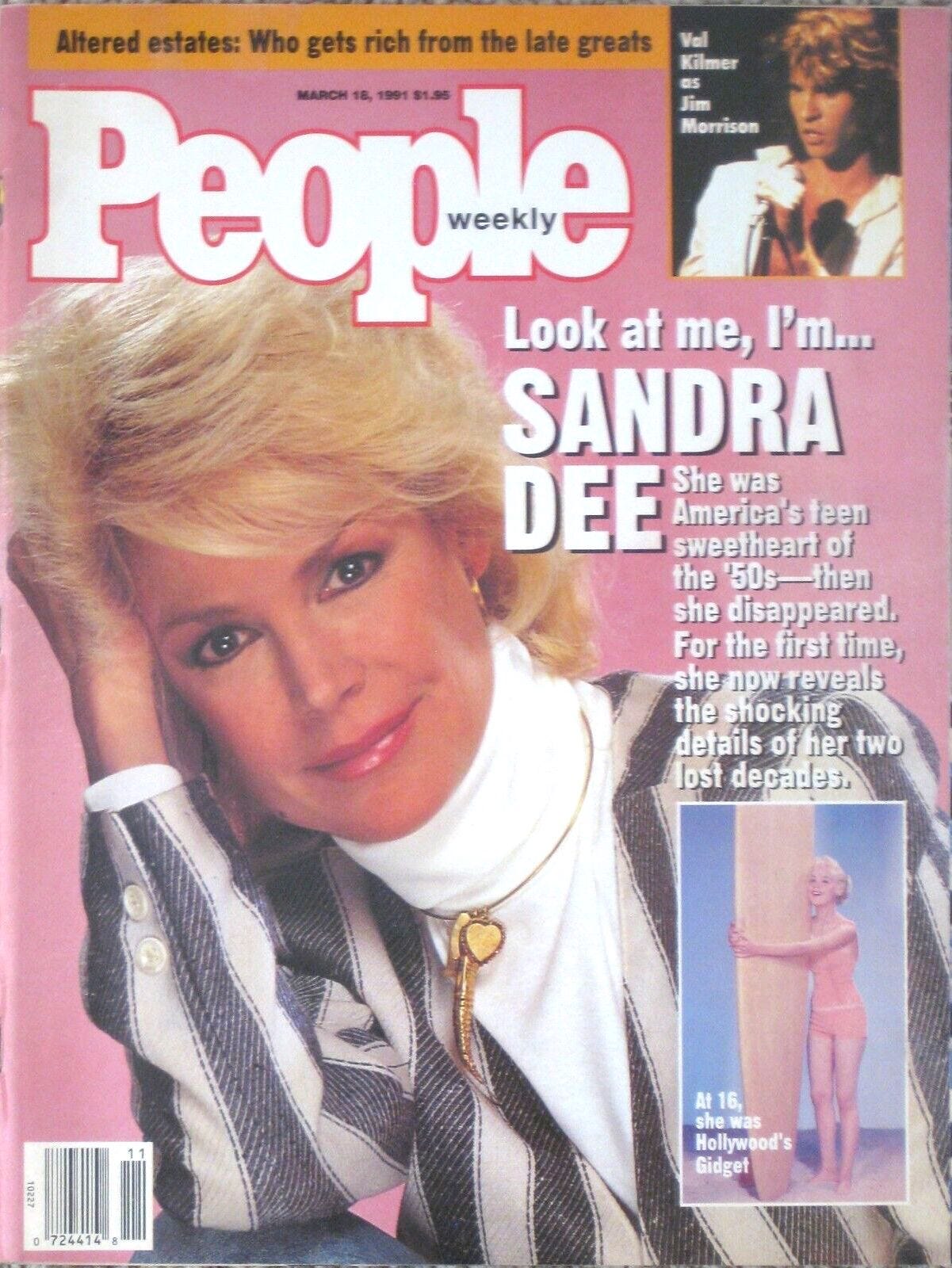
In doing so, Sandra Dee summoned a level of courage that few people could even comprehend. Her son Dodd wrote that once Dee went public about her past, she finally seemed to find some peace in her life. “Within a few months, she was a better and happier Sandra Dee. She stopped drinking, and she was eating, and driving her car, shopping, going to the gym. Her certain decline into death had been halted.”[5]
Sandra Dee lived for many more years, eventually dying on February 20, 2005, at age 62.
Gidget, in the end, has proven to be more than just a “beach movie.” It is a coming-of-age story, set against the backdrop of surfing culture and Southern California’s beaches. It is a story that speaks to the importance of family, friends, and community. And it reminds us that it is okay to be different and to go our own way. Gidget has withstood the test of time.
Gidget also stands as a reminder of the courage of its star, Sandra Dee. A victim of sexual abuse, she boldly spoke out about her experience long before the #MeToo movement came along. Her bravery in telling the world about her ordeal helped to pave the way for other victims of sexual abuse to come forward.
That singular act of courage is as much of a monument to Sandra Dee’s legacy as her spirited portrayal of Francine in Gidget. They both reveal different sides of a complex woman who possessed equal parts tremendous talent and remarkable resilience and fortitude.
NOTES
[1] Quoted in Georganne Scheiner, “Look at Me, I'm Sandra Dee: Beyond a White, Teen Icon,” Frontiers: A Journal of Women Studies, Vol. 22, No. 2 (2001), 92.
[2] “Sandra Dee Marries Bobby Darin Ahead of Schedule,” Jersey Journal (Jersey City, NJ), December 1, 1960, 1.
[3] Dodd Darin, Dream Lovers: The Magnificent Shattered Lives of Bobby Darin and Sandra Dee (New York: Warner Books, 1994), 336.
[4] Hadley Hall Meares, “Shooting Stars: The Ballad of Bobby Darin and Sandra Dee,” Vanity Fair, July 22, 2021. URL: https://www.vanityfair.com/hollywood/2021/07/sandra-dee-bobby-darin-relationship-marriage?srsltid=AfmBOopkTWvXOM5gzvPJ0otRwySYruS2cCxaIOoLfWDCfztv9KeEE3C0
[5] Darin, Dream Lovers, 348.



